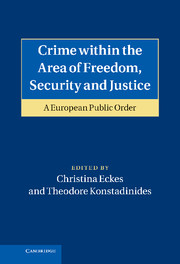Book contents
- Frontmatter
- Contents
- Contributors
- Acknowledgements
- ABBREVIATIONS
- Introduction
- 1 EU criminal justice: beyond Lisbon
- 2 The European Union policy against corruption in the light of international developments
- 3 The EU's anti-money laundering agenda: Built on risks?
- 4 EU anti-money laundering regulation: Multilevel cooperation of public and private actors
- 5 The legal framework of the European Union's counter-terrorist policies: full of good intentions?
- 6 Organised crime: developments and challenges for an enlarged European Union
- 7 The Europeanisation of extradition: how many light years away to mutual confidence?
- 8 The European Evidence Warrant: Mutual Recognition and Mutual (Dis)Trust?
- 9 Law and order and internal security provisions in the Area of Freedom, Security and Justice: before and after Lisbon
- 10 The external dimension of the EU's Area of Freedom, Security and Justice
- Index
- References
3 - The EU's anti-money laundering agenda: Built on risks?
Published online by Cambridge University Press: 01 June 2011
- Frontmatter
- Contents
- Contributors
- Acknowledgements
- ABBREVIATIONS
- Introduction
- 1 EU criminal justice: beyond Lisbon
- 2 The European Union policy against corruption in the light of international developments
- 3 The EU's anti-money laundering agenda: Built on risks?
- 4 EU anti-money laundering regulation: Multilevel cooperation of public and private actors
- 5 The legal framework of the European Union's counter-terrorist policies: full of good intentions?
- 6 Organised crime: developments and challenges for an enlarged European Union
- 7 The Europeanisation of extradition: how many light years away to mutual confidence?
- 8 The European Evidence Warrant: Mutual Recognition and Mutual (Dis)Trust?
- 9 Law and order and internal security provisions in the Area of Freedom, Security and Justice: before and after Lisbon
- 10 The external dimension of the EU's Area of Freedom, Security and Justice
- Index
- References
Summary
INTRODUCTION
The Third Money Laundering Directive introduces not only a risk-based approach to the fight against dirty money but also includes the financing of terrorism within its scope. The legal basis for such inclusion is Article 95 TEC (now Article 114 TFEU) and Article 47(2) TEC (now Article 53 TFEU) and the establishment and functioning of the internal market. This contribution aims to explore the implications of EC risk assessment in the area of the EU's anti-money laundering and terrorism financing regulation. In doing so, this chapter examines whether there are different notions of ‘risk’ at stake, i.e. within the traditional context of EU risk regulation and the sphere of money laundering/terrorism financing respectively. Moreover, the chapter addresses the cross-pillar overlap as well as the implications of the Lisbon Treaty in the present area.
This chapter is structured as follows. Firstly, a brief introduction is given of the EU's fight against money laundering and terrorist financing, and thereby in particular the Third Money Laundering Directive. Secondly, the notion of risk assessment in EC legislation is introduced in order to clarify the meaning of the catchword ‘risk’ as justification for EU involvement in the present area. Thereafter this chapter aims to discuss the implications of risk regulation in the framework of EU criminal law more specifically. In particular, it asks whether one could envisage an analogy with the EC law doctrine in this area where the focus is on how to link the notion of risk assessment with the general aim of crime prevention at the EU level.
- Type
- Chapter
- Information
- Crime within the Area of Freedom, Security and JusticeA European Public Order, pp. 76 - 96Publisher: Cambridge University PressPrint publication year: 2011
References
- 1
- Cited by



